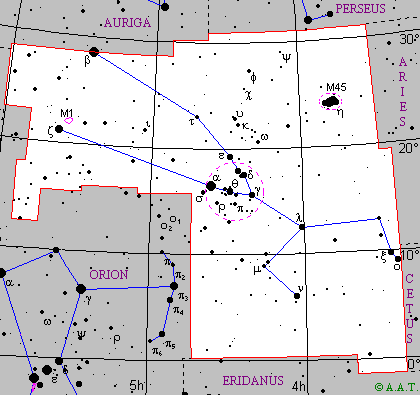 |
 |
| English name | Bull | ||||
|---|---|---|---|---|---|
| Major stars | alpha Tauri | Aldebaran | magn. 0,9 | RA: 04h 35m 55.23s | Dec: +16° 30' 33.8" |
| beta Tauri | El Nath | magn. 1,7 | RA: 05h 26m 17.51s | Dec: +28° 36' 27.0" | |
| zeta Tauri | magn. 3,0 | RA: 05h 37m 38.68s | Dec: +21° 08' 33.1" | ||
| eta Tauri | Alcyone | magn. 3,0 | RA: 03h 47m 29.07s | Dec: +24° 06' 18.4" | |
| Description | Constellation of the zodiac, through which the Sun transits from the middle of May to the end of June. Placed to the north of Orion, Taurus is rich in interesting objects. First of all the most shining star, Aldebaran: it is an orange giant that with its magnitude 0,9 is at the thirteenth place among the stars in order of brightness; it is 68 light-years away from us. Among the other stars of the constellation, remarkable are some double stars: theta and kappa Tauri, separable to the naked eye; sigma Tauri, a couple of white stars visible with binoculars; phi and chi Tauri, observable with small telescopes. The constellation of the Taurus contains two very famous open clusters: the Hyades and the Pleiades. The Hyades are about two hundred stars assembled in a very open group, about 150 light-years away: to the naked eye you can see a dozen of stars of the cluster, disposed in the characteristic V shape, near Aldebaran.
|
||||
| Mythology and history | Zeus fell in love with Europe, the daughter of the king of Phoenicia. One day he saw the young girl while she was playing on the beach with her maids: changed into a beautiful white bull, the king of the gods appeared among them and he docilely let himself be caressed. Considering that the animal was completely gentle, Europe jumped on his back: but the bull entered the sea and swimming he went quickly out to sea. Zeus led Europe to Crete, where he revealed his true identity and possessed her. And to remember this loving adventure, the king of the gods drew a bull among the stars. The Hyades represent the nymphs that raised the new-born Dionysus feeding him with milk and honey. |
||||
 Back to constellations page.
Back to constellations page.